Dog car sickness can put a damper on car trips. Your poor dog feels nauseous and anxious. And if your dog vomits in the car, you are left with clean-up duty. To help dogs who get car sick, integrative veterinarian Dr. Julie Buzby shares a two-part series on dog car sickness. In part one (this article), you’ll learn the factors that contribute to dog motion sickness, the symptoms to watch for, and what to do if your dog gets car sick. Then, in part two, you’ll discover a multitude of dog car sickness remedies.
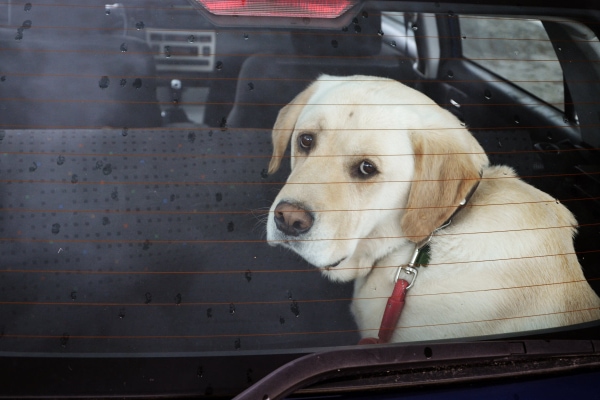
Tyler had been my client for years, and I always looked forward to seeing him and his dog Russell. On each visit, Russell was eager to cover me in sloppy dog kisses.
But when I walked into the exam room this time, Tyler quickly told me that I might not want to let Russell get too close to my face. Before I could ask, “Why not?” Tyler continued on to say that Russell had thrown up all over the car on the drive.
As I dug a little deeper, I discovered that they had recently moved. Instead of their usual five-minute drive to the clinic, the trip now took about an hour on winding country roads. Unfortunately, it seemed that Russell’s stomach did not handle the change in scenery very well, causing him to experience dog car sickness.
In addition to performing his wellness exam and vaccinations that day, we also discussed motion sickness in dogs. And I gave Tyler some tips that could hopefully make future drives more pleasant for both of them.
I know Russell isn’t the only dog who has suffered from car sickness. So I thought it was time to share a bit about why it happens with other dog parents.
What is dog car sickness?
Normally, every detail your dog’s nervous system collects gets transmitted to the brain. These bits of information work together to help the brain receive, process, and respond to, information about your dog’s body and the world around it.
But in some situations, the surroundings are moving or changing so quickly that the brain cannot properly determine what is happening. For example, if the car is driving fast, images can blur or move in an abnormal way. The inner ear (which also helps determine the dog’s position and motion) may feel unbalanced and “lost in space.”
This conflicting input from the eyes and inner ear confuses the brain, which can lead to motion sickness and the associated discomfort, anxiety, dizziness, and vomiting. Motion sickness can happen in a variety of situations (boats, trains, planes, cars, buses, etc.). Since cars are the most common mode of transportation for dogs, the focus here is on car sickness in dogs. But the information can easily translate to boat, train, bus, or plane sickness too.
Why do dogs get car sick?
In dogs, motion sickness can happen for three main reasons:
1. Improper sense of balance in the car
As described above, your dog’s senses help your dog process his or her surroundings. The eyes play an important role in detecting motion and recognizing orientation. Additionally, the information from the inner ear is critical for maintaining balance and your dog’s “sense of space” in relation to his or her surroundings.
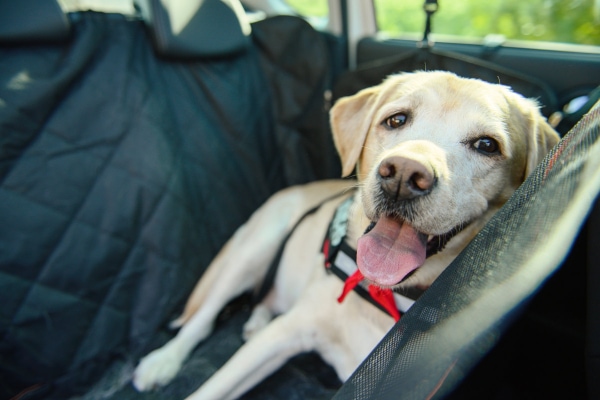
If the delicate structures of the inner ear are damaged or underdeveloped, the inner ear cannot recognize and respond to motion properly. Now the eyes and inner ears don’t communicate the same signals—therefore confusing the brain. As a result, your dog feels unbalanced and can experience motion sickness.
2. Car-related anxiety
Dogs who are anxious and stressed in the car can become overwhelmed. This can lead to vomiting and diarrhea in the car. If this happens to a dog multiple times, the dog will begin to correlate the car with feeling nauseous—leading to more anxiety and an increased risk of car sickness.
3. An already upset stomach
If your dog ate something that he or she shouldn’t, your dog might get sick in the car (even if he or she doesn’t usually experience motion sickness). Or, if your dog has abdominal pain and/or nausea due to a medical condition, he or she has a higher chance of getting motion sick.
Which dogs are most likely to develop car sickness?
Now that we have answered the questions “Can dogs get motion sick?” and “What causes dogs to have car sickness and throw up?” we can discuss more of the specifics of which dogs are at the greatest risk of becoming sick during road trips.
Dogs with inner ear problems
As discussed above, inner ear abnormalities can make a dog prone to car sickness. Sometimes it is simply a matter of the inner ear not being fully developed yet. Such is the case with puppies. This is one reason young dogs are more likely to experience car sickness than adult dogs. Thankfully, if the motion sickness is related to an immature inner ear, puppies can grow out of it by about 1-year-old.
In other situations, the dog has experienced damage to the inner ear. For example, dogs who have been diagnosed with severe ear infections (i.e. otitis in dogs) that have reached the inner ear can become car sick more often. And older dogs with vestibular disease in dogs have problems with balance, orientation, and motion sickness.
Dogs who are anxious in the car
Anxiety can also turn into car sickness for some dogs. Or the dog may become anxious because he or she is feeling motion sick. Sometimes it is a bit of a chicken-and-egg scenario. But regardless, there are many reasons dogs suffer from car-related anxiety. Some of the most common include:
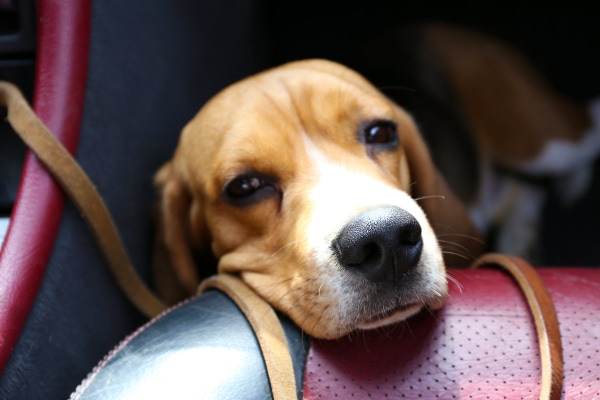
Previous bad experiences in the car
Sometimes dogs learn car rides are unpleasant because they end up somewhere they didn’t want to go. Or if dogs have gotten car sick in the past, they may start to associate the car with feeling sick. Understandably, the dog is then more likely to be anxious in the car. Dogs who have been in car accidents or other stressful situations are also more prone to feeling nervous the next time they ride in a vehicle.
Only taking car rides to places the dog doesn’t want to go
One of the main reasons the car becomes a bad experience is because the dog only rides in the car once or twice a year. And each time the dog goes in the car, he or she ends up somewhere that he or she would rather not visit.
This might be the groomer or veterinary hospital where scary, new things happen to your dog. Or the trip might end at the boarding facility (which is a fun adventure for some dogs but intimidating or lonely for other dogs).
If your dog only goes in the car to go to these spots, he or she will begin to associate the car with the upcoming experience. And that can lead to anxiety and car sickness.
Your mood or behavior in the car
Dog parents (and vets) sometimes forget to think about how their mood can impact their dog. Your dog is your best friend and spends most of his or her time with you. Therefore, your dog knows you very well and detects your stress faster than you might be able to. And if you are upset, your dog can become anxious too.
Many people become anxious, stressed, or mad in the car at some point. Whether you are stressed because you got off work late and now must rush to the vet, anxious because you don’t like driving in traffic, or angry because someone just cut you off, your dog detects these emotions—especially if you yell or make big hand gestures.
Your poor dog doesn’t know you are yelling at the person in front of you or the red light that seems never-ending. To your pup, there is obvious unhappiness associated with the car. And your canine passenger isn’t sure if you are directing those feelings at him or her. This can make your dog nervous and uncomfortable.
Uncomfortable environment in the car
Along with owner stress, there are many other factors associated with car travel that can make a dog feel ill at ease. For example:
- The air pressure changes that occur as you change elevation can feel unfamiliar and scary to your dog.
- Roads with sharp turns or curves that are taken too fast can make your dog feel unbalanced and unstable. Your dog may feel like he or she could fall over and get hurt at any moment.
- If it is hot in the back of the car because your air conditioning doesn’t reach behind the seat or the windows aren’t down, this can make your dog uneasy or nauseous.
- The loud music that helps put you in a good mood and decompress from the day is even louder for your dog. This could cause stress—especially if the base is vibrating and your dog detects it.
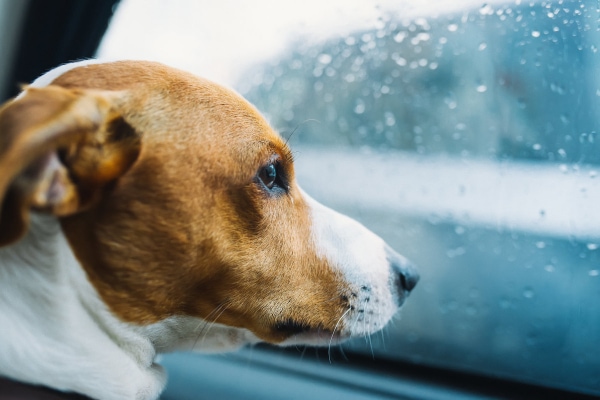
Lack of “car training”
As you can see, there are a lot of aspects of a car ride that seem completely normal to you and me but might be scary and intimidating to your dog. Therefore, many dogs need “car training” before they can ride in the car and enjoy it. Just like dogs need to learn that the leash isn’t scary, and neither is the dog kennel, they also need to understand that cars are a safe place to be.
The best way to do this is through positive reinforcement and praising your dog in the car. However many dogs haven’t received this type of training because it is not something most dog parents think about. After adopting a dog or puppy, it comes naturally to work on house training and teaching the dog not to chew up shoes. But training a dog to ride in the car may not cross many dog parents’ minds.
All of these factors taken by themselves, or added together, can make a car ride very stressful for your dog. And without making some changes or teaching your dog to see car rides as good, the anxiety can worsen and lead to car sickness.
Dogs with nausea-inducing medical problems
Finally, as discussed previously, dogs who are nauseous or vomiting for other reasons are also more likely to become car sick. While there are a lot of conditions that could fit that description, some of the more common ones are:
- Pancreatitis in dogs
- Liver disease in dogs
- Kidney failure in dogs
- Diabetic ketoacidosis in dogs (DKA)
- Ingesting a dog toxin like chocolate or a foreign object
- Gastroenteritis (i.e. inflammation of the stomach and intestines)
In these situations, the bigger problem is the medical condition causing the vomiting, and not necessarily the car itself. However, it is good to keep in mind that remembering that they felt sick in the car and ended up at the vet for tests and treatment could make some dogs anxious about future car trips.
How do you know your dog is anxious in the car?
Dogs with medical problems (e.g. inner ear problems or conditions leading to nausea) may not initially be anxious when they get in the car. But they may become stressed if they start feeling sick. On the other hand, dogs with car-related anxiety might be nervous from the start.
Either way, I recommend all dog parents watch for signs of anxiety whenever they are riding in the car with their dog. Some of these signs include:
- Pacing
- Panting
- Excessive drooling
- Whining or whimpering
- Barking more than normal
- Trembling and shaking
- Eyes wide with whites showing more than normal
- Tail tucked between legs
- Unable to settle down
- Unwilling to sit or lay down
- Trying to climb over seats or change location within the car
- Excessively licking or chewing at the paws
Some dogs with anxiety will show only one or two of these signs. Others may show all of them. Alternatively, stressed dogs may be too nervous to move. They might just lay down and tremble or refuse to budge from their spot.
If your dog is showing any of these signs of anxiety, it is possible that the stress could continue to build. And then your dog might become car sick.
Or these symptoms might indicate your dog is already feeling poorly.
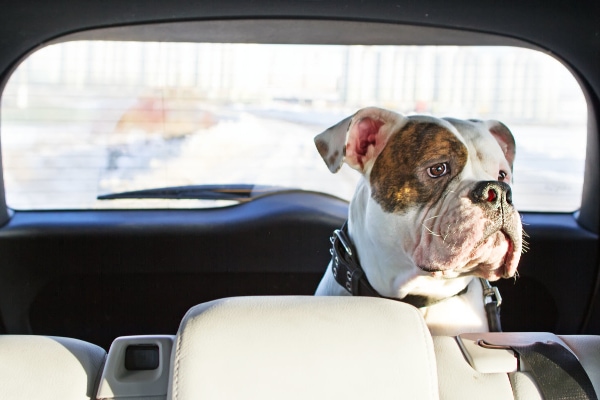
What are the symptoms of dog car sickness?
While dogs can’t tell us they are feeling sick, there are some signs that indicate your dog might be nauseous. As discussed, many dogs who are getting car sick will show some anxiety symptoms. Plus, you might notice signs like:
- Pacing or being unable to lay down
- Whining or whimpering
- Drooling and panting
- Smacking lips or a dog who keeps licking his or her lips
- Being a lethargic dog
- Gagging or retching
- Vomiting
- Pooping in the car or having diarrhea
Some of these signs are easier to recognize than others. But if you suspect that your dog is going to be sick, stay calm and find a safe place to pull over and get your dog out of the car.
What do you do if your dog gets sick in the car?
The best-case scenario is that you caught your dog’s nausea in time and were able to pull over before he or she threw up. If you are this fortunate, take your dog for a walk in a safe location. (But be ready to grab his or her leash or collar when you open the car door. Some dogs are very eager to jump out of the car and get far away from the “scary” vehicle.) Getting some fresh air and regaining balance and orientation will help your dog feel less nauseous. It also might relieve some of your dog’s anxiety.
Don’t offer your dog food or large amounts of water during this time. Doing so could upset your dog’s stomach more and cause him or her to vomit.
Once your dog appears more relaxed and less sick, you can return to your car and proceed with your drive. Try to make the car ride as comfortable and relaxing for your dog as possible. There are a few tips in a later section, but I will discuss this more in part two of the series.
If you unfortunately did not pull over in time and your dog did vomit or defecate in your car, I am sorry! This experience is not fun for you or your dog. But it is important that you stay calm and don’t yell at or punish your dog. It’s not your dog’s fault that he or she felt sick, and scolding your dog could increase anxiety.
Guidance for if you are close to where you are going
If you are close to your destination, decide if you want to pull over or keep driving. If you continue, do not try to clean up the mess while driving. Instead, turn down the music and turn up the AC. Try to make the rest of the car ride as comfortable for your dog as possible.
Guidance for if you are far from your destination
If you have a long way to go in the car still, pull over when there is a safe location to do so. Carefully let your dog out of the car. Ensure you have a hold of the leash in case your dog tries to rush out of the car. Then give your dog some time to walk around outside and calm down. This might decrease the chance of him or her becoming sick again.
You can also take a few minutes for yourself. Clean up the mess and try to regain your own composure after dealing with this unpleasant situation. Once you and your dog return to the car, attempt to keep your dog comfortable and relaxed as you continue your trip.
How long does motion sickness last in dogs?
Whether you make a stop or keep on driving, once you reach your destination, let your dog out of the car. (Be prepared for the possibility that your dog may try to bolt.) Take a nice calming walk and clean up the car, if you haven’t already.
Thankfully, many dogs will begin to feel better as soon as the car has stopped moving and they are walking on solid ground again. However, some dogs may continue to feel nauseous for about 30 minutes after the car stops—especially if it was a long road trip or your dog was very sick.
How do you treat car sickness in dogs?
If your dog appears nauseous for a while after stopping the car, wait at least 30 minutes to offer food and large amounts of water. This will allow your dog’s stomach to settle before consuming anything.
Since the nausea usually subsides after getting out of the car, most dogs don’t need a specific treatment for motion sickness after the fact. However, anti-nausea medications or other treatments prescribed by the veterinarian can be helpful for dogs who get car sick due to an underlying medical condition that is also causing nausea or vomiting.
How can you keep your dog from getting car sick in the future?
If your final location was the veterinary hospital, tell the vet that your dog was car sick on the ride there. Otherwise, make a note to discuss it with your veterinarian at the next appointment. Or give the veterinary team a call at your convenience.
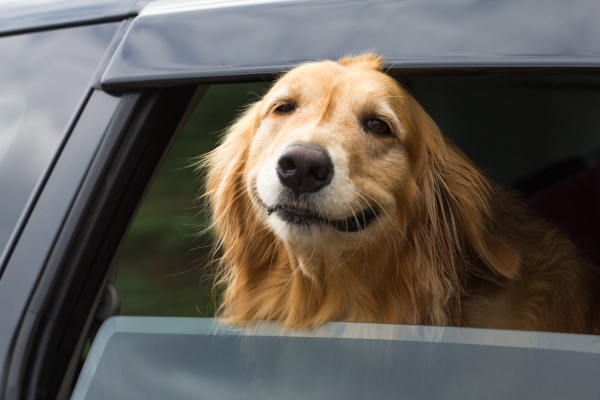
Your vet will probably ask questions about your dog’s previous experiences in the car and your dog’s stress level. This is to help your vet determine what caused your dog to feel nauseous. Then he or she can work with you to create a plan to hopefully prevent motion sickness in the future. I go into significantly more detail about this topic in part two of this series, but I wanted to provide a few highlights for you now.
- Teach your dog that the car is a positive place—start out with just having your dog in the car for a few minutes at a time, gradually building up to short drives, then longer ones. Pair this with praise and special toys or treats.
- Ask your vet about giving your dog over-the-counter medications like Dramamine or Benadryl for dogs, or prescription anti-nausea medications such as Cerenia for dogs or meclizine for dogs prior to the trip
- Consider withholding food for 8-12 hours before the trip (but continue to allow your dog access to water to help your dog remain hydrated and keep your dog cool in summer).
- Make the car comfortable for your dog by keeping the car cool, bringing something familiar from home, keeping the music quiet, staying calm, and using a dog seat belt or crate. (Remember that using car restraints for dogs saves lives—both your dog’s and yours.)
- Talk to your vet about natural calming products or anti-anxiety medications for dogs like fluoxetine, gabapentin for dogs, or trazodone for dogs.
What worked for my patient?
After discussing Russell’s case with Tyler, we determined that Russell was anxious in the car now that the rides were longer and on curvy roads.
I sent Tyler home with instructions for desensitizing Russell to the car and helping him associate it with good things. Also, since Russell was a very toy-motivated dog, Tyler was going to buy a new toy just for car rides.
A few weeks later, Tyler called my office to let me know that the training was going well. Russell started enjoying car rides again—as long as he had his new favorite toy in the seat with him. Russell was no longer getting sick in the car either. I was thrilled with Russell’s progress, and so was Tyler!
Get to the bottom of your dog’s car sickness
If your dog is also struggling with car sickness, you can do the same thing Tyler and I did for Russell. Think about the factors that influence car sickness—Is your dog young? Did he or she have a bad experience in the car? Are you seeing signs of anxiety? Does your dog ride in the car infrequently? Have you ever tried to “car-train” your dog? Do you think your dog might have a medical condition that is contributing to his or her car sickness?
Once you (with the help of your veterinarian) figure out why your dog might be getting car sick, you can create a plan to decrease your dog’s motion sickness. And hopefully, you and your dog will be having nausea-free, anxiety-free, trips in the car soon!
What do you think contributes to your dog’s car sickness?
Please comment below.


Our 11 month old spayed pbgv gets car sick. I think we need to help her associate fun with the car. But it’s tough because she gets so sick before the fun can even begin at the park, or hiking area.
Hi Katherine,
I am sorry your young pup has issues with car sickness. Hoping you can work toward a positive association with the car! Don’t hesitate to talk to you vet about using an anti-nausea medication if needed. Wishing you and your girl the best of luck.
my puppy was recently diagnosed with EPI… she was fine on long car rides and rides around town… she is now on pancreatic enzymes and has to eat 3 meals a day for a while to get the weight back on..
last week she the up in the car… this week she was very drooly….
can the enzymes cause car sickness?
Hi Sb,
This is a great question, but unfortunately, I am not sure of the answer. I have never had a client mention a new development of car sickness after starting treatment for EPI. My guess is the nausea is probably due to the underlying GI issues themselves and not necessarily the enzymes that are being supplemented. If I come across any new information about this, I will be sure to post a reply. Best wishes and take care!